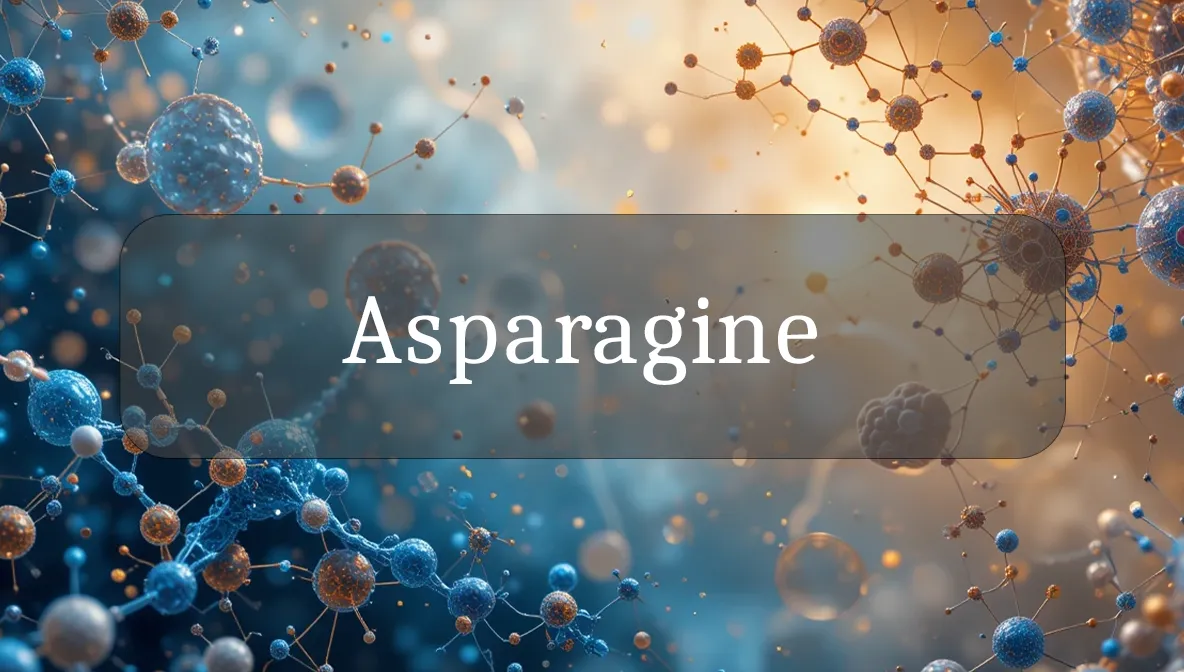Amino Acid for Brain and Energy Balance
Asparagine might not be a term you hear every day, but it’s a hardworking amino acid that acts like a quiet supporter in your body, helping build proteins, boosting brain function, and keeping energy levels steady. Found in foods like asparagus, dairy, and seafood, asparagine is a key player in daily wellness, especially for those seeking mental clarity and vitality. Let’s dive into what asparagine is, why it matters, and how to support it for a healthier you, all in a friendly, easy-to-understand way.
Identity and Type
Asparagine, also known as L-asparagine, is a non-essential amino acid, meaning your body can produce it on its own, but you can also get it from food. It’s a building block for proteins and plays a role in creating other molecules like aspartic acid and ammonia. Asparagine is found in cells and is vital for protein synthesis and metabolic balance. Think of it as a nutrient that helps your body stay strong and focused.
Biological Role and Health Benefits
Asparagine is like a behind-the-scenes helper, supporting essential functions:
- Protein Synthesis: It’s a key component of proteins, helping build muscles, enzymes, and tissues, keeping your body strong and functional.
- Brain Health: Asparagine supports the production of neurotransmitters, aiding memory, focus, and mood balance, promoting mental clarity.
- Energy Metabolism: It helps regulate ammonia levels in the body through the urea cycle, preventing fatigue and supporting steady energy.
- Immune Support: By contributing to protein production, asparagine strengthens immune cells, helping your body fight infections and stay resilient.
- Cell Function: It maintains cell hydration and structure, ensuring cells work smoothly for overall health.
By supporting proteins, brain function, and energy, asparagine boosts daily vitality.
Dietary Sources and Supplements
Asparagine is found in protein-rich foods and available in some supplements:
- Dietary Sources:
- Vegetables: Asparagus (1 cup = ~130 mg), potatoes, and spinach.
- Meats and Seafood: Beef, chicken, turkey, and fish (e.g., cod, salmon).
- Dairy: Milk, cheese, and yogurt.
- Plant-Based: Soybeans, peanuts, almonds, and whole grains (e.g., oats, wheat).
- Other: Eggs and legumes (e.g., lentils, chickpeas).
- Supplements:
- L-asparagine is rarely sold alone but may be included in amino acid blends, protein powders, or medical formulas for specific conditions.
- Used in clinical settings (e.g., for certain cancers) but not common for general health.
- Body Production: Your liver and other cells synthesize asparagine from aspartic acid and glutamine using the enzyme asparagine synthetase, meeting most needs unless under stress.
- Environmental Sources: Asparagine is in the food chain through plants and animals, with diet as a key source.
A balanced, protein-rich diet typically provides enough asparagine for most people.
Signs of Imbalance
Asparagine imbalances, usually deficiency, are rare but can affect energy and brain health, while excess is uncommon:
- Low Asparagine:
- Symptoms: Fatigue, poor focus, muscle weakness, or slow wound healing. May include mood changes or weakened immunity.
- Causes: Severe protein malnutrition, chronic illness (e.g., liver disease), or genetic defects in asparagine synthesis (very rare).
- Impact: Can impair protein production, brain function, or energy metabolism, reducing vitality.
- Excess Asparagine:
- Symptoms: Rare, but high supplemental doses may cause digestive upset or ammonia buildup, leading to nausea or confusion.
- Causes: Overuse of amino acid supplements or medical asparagine therapy (e.g., for leukemia treatment).
- Impact: May stress the liver or kidneys in extreme cases.
If you notice fatigue, brain fog, or weakness, consult a doctor to assess protein or amino acid status.
Supporting Optimal Levels or Function
Ensuring healthy asparagine levels is simple with diet and lifestyle:
- Eat Protein-Rich Foods: Include 3–4 oz lean meats (e.g., chicken, fish) or 1 cup asparagus daily for ample asparagine. Add plant-based options like soybeans or peanuts for variety.
- Balance Protein Intake: Aim for 0.8–1.2 g protein per kg body weight daily (e.g., ~56–84 g for a 70 kg person) to support asparagine and other amino acids. Combine animal and plant sources for diversity.
- Support Metabolism: Eat folate-rich foods (spinach, lentils) and vitamin B6-rich foods (bananas, chickpeas) to aid amino acid metabolism. Stay hydrated (8–10 cups water daily) to help clear ammonia.
- Exercise Moderately: Engage in 30 minutes daily of exercise (e.g., walking, strength training) to boost protein synthesis and use asparagine effectively.
- Prioritize Sleep: Get 7–8 hours nightly to support brain health and protein repair, enhancing asparagine’s role in recovery.
Blood tests for amino acid profiles or liver function can assess asparagine status if needed.
Safety, Interactions, and Precautions
Asparagine is safe in dietary amounts, but supplements require caution:
- Safety: Dietary asparagine from foods is safe for most. Supplemental asparagine is rare and unnecessary for healthy individuals, with potential for digestive upset at high doses.
- Interactions: Asparagine supplements (if used medically) may interact with chemotherapy drugs or affect ammonia metabolism. Consult a doctor if on such treatments.
- Precautions:
- People with liver or kidney disease should avoid supplemental asparagine, as it may stress ammonia clearance.
- Those with rare metabolic disorders (e.g., asparagine synthetase deficiency) need medical guidance for amino acid intake.
- Avoid unguided high-dose amino acid supplements, as they may disrupt amino acid balance.
- Storage: Store protein-rich foods (e.g., dairy, meats) in the fridge or freezer. Keep amino acid supplements in a cool, dry place, sealed tightly.
Fun Fact
Did you know asparagine was named after asparagus? It was first discovered in asparagus juice in 1806, and this veggie remains one of the tastiest ways to get this brain-boosting amino acid!
Citations
- National Institutes of Health (NIH). (2023). Amino Acids and Health.
- Mayo Clinic. (2024). Protein and Amino Acids: Overview.
- Cleveland Clinic. (2023). Amino Acids and Metabolism.
- World Health Organization (WHO). (2022). Protein and Amino Acid Requirements in Human Nutrition.
- USDA National Nutrient Database. (2023). Amino Acid Content in Foods.

